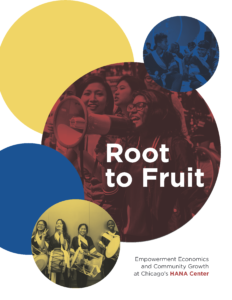Root to Fruit: Empowerment Economics and Community Growth at Chicago’s HANA Center
by Institute of Assets and Social Policy (IASP), in partnership with National CAPACD and HANA Center
November 2019
Root to Fruit: Empowerment Economics and Community Growth at Chicago’s HANA Center lifts up one of our member organization, The HANA Center, and its cutting edge approach to financial capability which is shaped by its youth-led empowerment and community organizing programming. Low-income youth of color at HANA Center are redefining what it means to “own wealth” or “build assets,” demonstrating that their greatest asset is their collective power. This is truly Empowerment Economics in action.
The HANA Center’s mission is to empower Korean American, immigrant, and multi-ethnic communities through social services, education, culture, and community organizing to advance human rights. HANA is committed to serving the diverse interests of its community – including immigrants, women, youth, people of color, low-income families, older adults, LGBTQ+ folks, and adoptees.
This case study is unique because it explores how to practice Empowerment Economics in a multi-ethnic community. Since one of the principles of the Empowerment Economics framework is to be culturally responsive and relevant to the community it serves, people often ask if it is possible to practice Empowerment Economics in a mixed or multi-ethnic community. HANA Center’s youth empowerment and organizing programs draw youth from a range of backgrounds, and the HANA Center places a strong emphasis on knowing about and celebrating each participant’s roots.
Read the Executive Summary to get an overview of the case study here.
Read the full case study here.



